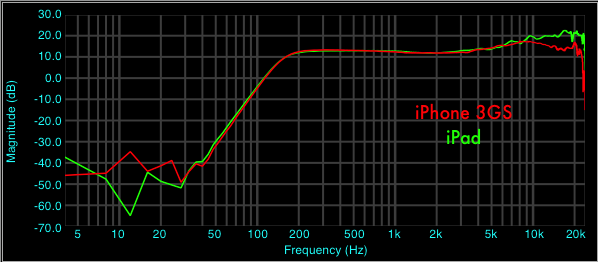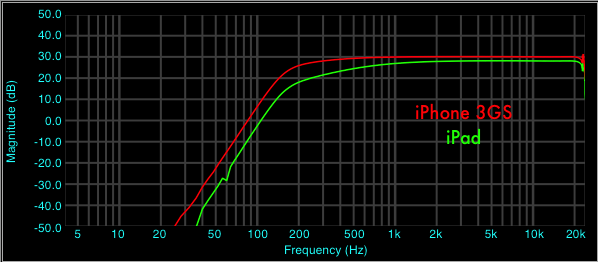iPad Audio Input Options
It turns out that in some ways, getting audio signals into the iPad is similar to getting audio signals into the iPhone 3GS, and in some ways it’s not. Like the iPhone, the iPad includes a built-in microphone as well as support for a headset microphone through its headset jack. Unlike the iPhone, the iPad does not support audio line level input via the 30-pin dock connector, so you won’t be able to use existing iPod mic/line accessories with your iPad.
The iPad’s lack of audio line input support would appear to be a major limitation of the device, particularly for audio test and measurement apps. However, it turns out that the iPad can act as a USB host with support for 16-bit, 48 kHz USB Audio Class compliant devices. All you need to do is plug a compatible USB audio device into the USB port of the iPad Camera Connection Kit and you’re good to go. (I’ll spend more time explaining what “compatible” means in a future post.)
Frequency Response
So how does the frequency response of the built-in microphone and the headset input compare? I measured both and offer comparisons with the iPhone 3GS. It turns out that the two devices have very similar characteristics for their mic inputs.



Thanks! Just starting to explore iPad capability. I wonder if it is possible to use audio input from a Bluetooth device? The manual leaves that out or might be indicating that it doesn’t?
Just a question….
…. on the “headset input” graph, it this with a direct connection or using the actual headset mic in a chamber?
Tom
That’s a direct electrical connection.
Great work Ben. I’ve been reading several of your blog entries. You seem to be doing some really good work at Faber Acoustical. I was wondering if you’ve published those frequency responses in some peer-reviewed journal, or anywehre other than this blog. It may do quite a good service to the audio/acoustical research community if these were published in a peer-reviewed sphere that could be referenced in academic work. Let me know if you have already done something like that. I’m essentially looking for the best way for me to reference your work. Thanks!
Nicolas
Hi. I can’t understand how did you make recording through “electrical connection” through headset jack.. I have tried to record this way in ipad 2 , but it always recording through microphone. What do I need to do, to record with aoudion input throug headste jack? thanx
Same problem, like Taras with ipad2…
hi ben,
tieline.com pointed me to this site. i’m a (german) radio reporter and am testing tieline’s “Report-IT” app on my iPad 1. my first tests showed similar results as the ones you published here: using a recording app the built-in mike produces a good, precise, but no warm sound, i.e., the low frequencies are missing.
since i have excellent microphones at hand i purchased the iRig – with similar, disappointing results. however, the GarageBand app recorded a signal with the full frequency spectrum. strange. i wonder why the other apps (such as the brilliant DAW MultiTrack) drop the low frequencies.
since for reporting live i had to rely on the audio capacities of the Report-IT app, i didn’t get the results i wanted with the iRig and a good microphone.
my third step was to try a dedicated USB-mike (samson meteor). this microphone uses the camera connection adapter and reproduces a well balanced sound in all audio apps – and over Report-IT. it’s not excellent, but good enough for broadcasting live. actually, the limitations are the audio codec and/or 3G-bandwidth, not the mike.
what i found interesting are the iPhone-only encounters of my english collegue nick garnett. on his website nickgarnett.co.uk he demonstrates the usage of the iPhone running the (pretty costly) Luci broadcasting app in a harsh broadcasting environment. i measured the frequencies of nick’s broadcast (he used only the iPhone and the app, no external mike). the spectrum ranges well below 150 Hz; the lowest frequencies i measured were around 80 Hz.
what do you all make of this jungle of info?
The ipad2 can obviously measure down to DC since it can report inclinometer data. I wish to record infrasound. Is there a way to get an audio input to the accelerometer or inclinometer channels?
All iOS devices can monitor DC values from the accelerometer, but none of them can acquire DC through their audio inputs.
Hey Ben,
I have been looking everywhere to the answer to a question and im hoping this is the right forum to ask it.
In your article you mention that the iPad does not support audio line level input via the 30-pin dock connector, and I have also read from other sources that it has been “reserved” – the only problem being there are devices out there (the Apogee Jam and Alesis io dock are just a few) that do manage to send an audio in signal via the 30 pin connector.
How do they accomplish it if the iPad does not support it? Im trying to build a DIY version of the Apogee Jam to use with GarageBand and Amplitube to get a clean digital signal – and while the 30 pin breakout clearly labels one of the inputs as audio in – im hoping to clarify this issue before I break out the soldering iron and put the cash down for parts.
Any information or help that you or anyone else in the community could provide on the issue would be super appreciated. Thanks in advance!
Any input you can give me
Salman,
Accessories can move data across the 30-pin connector, so even though the analog input pins are no longer supported, devices like the Jam and iO Dock can obviously still provide analog input.
This blog isn’t the place to learn about DIY accessories. For official accessory development support, I recommend joining Apple’s MFi program.
Ben